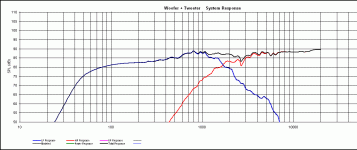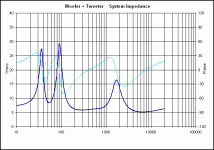The XLS-encore uses components that add up to more than the purchase price because they are being sold at a loss. Peerless paper cone woofers,
Remember that they're Peerless India woofers, not the Peerless most audio hobbyists think of when the word "Peerless" comes up.
It's a wholly separate company.
Keilau,
This thread is going kind of in a ridiculous manner. I was really looking forward to constructive, specific criticism, or alternative designs when I started the LM-1.
If anyone would like to participate, the LM-1 crossover files are available, I look forward to helpful, constructive and specific suggestions, which I have solicited since the very beginning. It disappoints me that this criticism comes with such personal rancor which makes it's hard for me to take any of it seriously. I hope instead that anyone participating can return to being as civil as I am used to seeing here.
I remain open to the idea that something went wrong in my sensitivity measurements, either operator error or tool error but it is not entirely impossible that it is 5 dB. For instance if the Continuum's have enough BSC. Again, I am open to the idea of an error of measurement, and apologize I won't be able to return to that for a while.
I do want to say I hope you can all see how puzzled I may be at this reception, or lack thereof. The very first criticism I received was along the lines of the LM-1 lacking parts. << sigh >>
Best,
Erik
I apologize if my post offended you. Just forgive me and focus on other helpful posts that you received. This is a wonderful forum for anyone who wants to learn.
I was in the same boat as a beginner speaker DIYer (and still is) a year ago. I found that the crossover design I developed was not getting me the expected result. It was not bad for a first try, but something was missing. I started a thread asking for critique and help.
http://www.diyaudio.com/forums/multi-way/278728-crossover-modest-diy-bookshelf-speaker-project.html
When people realized that it was work-in-progress, and not a finalized design of wonderful sound, they feel free to comment. And the follow-on exchanges were amazing.
I learned a lot from many helpful fellow forum members after a week and 60 some posts. Their suggestions were borned out by measurements and correlated well with my own listening impression. The final crossover was very different from my original and improved the sound tremendously.
I cannot emphasize enough on how important it is to tailor the BSC and add components to eliminate the woofer response bump in the upper midrange. I also found that a symmetrical 3rd order crossover work the best for me. The woofer roll-off is part of the low pass filter.
Last edited:
Remember that they're Peerless India woofers, not the Peerless most audio hobbyists think of when the word "Peerless" comes up.
It's a wholly separate company.
Despite being from India (I did not know this), they are excellent drivers - treated paper cone with open polymer basket, nice smooth response and good sensitivity. I would buy more for other projects as the value is excellent.
I once brought a reference system to gr-research to evaluate his eaton kits. I didn't find them significantly better than the B&W 805's I was using on the top end.
But after he let me audition the eatons he then played me his reference system. INCREDIBLY good. And much cheaper than what I had brought.
Danny is a great guy and I wouldn't hesitate to trust his opinion or support his company as both are excellent.
Sent from my iPad using Tapatalk
But after he let me audition the eatons he then played me his reference system. INCREDIBLY good. And much cheaper than what I had brought.
Danny is a great guy and I wouldn't hesitate to trust his opinion or support his company as both are excellent.
Sent from my iPad using Tapatalk
I remain open to the idea that something went wrong in my sensitivity measurements, either operator error...
Erik
The way your initial low passed woofer response looks like, seems you have
spliced the two in a way so they appear similarly high in SPL. The splice is in
the 500-600 Hz range. Naturally, we are not that lucky to have such high
sensitivity from such a unit. I am attaching my free field sim (Fb=50Hz)
from manufacturer's plots and your cabinet and filter values.
There is a white paper by Bagby called "How to Achieve Accurate In-RoomQuasi-Anechoic Free-Field
Frequency Response Measurements Down to 10 Hz". Good stuff.
Attachments
The baffle step loss is a killer. My current project uses RS180P-8 nominally 89dB seem to be a genuine 83dB to 84dB speaker after the baffle step losses. Many commercial speakers (2 ways) of typical cost and design are highly over-rated in their sensitivity as it's physically impossible to achieve any moe than say 84dB for a 90dB driver with a reflex or sealed alignment.
The only time I have seen a speaker that has bass output equivalent to its nominal sensitivity rating is when a special TL or BLH cabinet is used to capture and amplify the bass output from the back of the cone. The mini Karlsonator is a ML-TQWT that achieves about -1dB loss from nominal rating so gets 90dB at 80Hz with 91dB rated Faital Pro 3FE25 drivers. So for a tiny speaker, the bass is surprisingly powerful and much larger than expected. This is the only speaker I have made (other than wall mounted units which don't suffer -6dB baffle step loss) that comes close to nominal sensitivity ratings after baffle step losses. Sealed and reflex speaker that I have made have always measured -5dB to -6dB less than manufacturer's rating in 4pi space.
The only time I have seen a speaker that has bass output equivalent to its nominal sensitivity rating is when a special TL or BLH cabinet is used to capture and amplify the bass output from the back of the cone. The mini Karlsonator is a ML-TQWT that achieves about -1dB loss from nominal rating so gets 90dB at 80Hz with 91dB rated Faital Pro 3FE25 drivers. So for a tiny speaker, the bass is surprisingly powerful and much larger than expected. This is the only speaker I have made (other than wall mounted units which don't suffer -6dB baffle step loss) that comes close to nominal sensitivity ratings after baffle step losses. Sealed and reflex speaker that I have made have always measured -5dB to -6dB less than manufacturer's rating in 4pi space.
Last edited:
The baffle step loss is unavoidable (may be except for OB). Fortunately, due to the work of Jeff Bayby and others, the baffle step compensation can be easily simulated in the crossover design.
The actual amount of baffle step loss is cabinet and room placement dependent and varies from -3 dB to -6 dB in a typical room. It makes on-site measurement necessary which can be accomplished with inexpensive calibrated microphone and free software.
The actual amount of baffle step loss is cabinet and room placement dependent and varies from -3 dB to -6 dB in a typical room. It makes on-site measurement necessary which can be accomplished with inexpensive calibrated microphone and free software.
The baffle step loss is unavoidable (may be except for OB). Fortunately, due to the work of Jeff Bayby and others, the baffle step compensation can be easily simulated in the crossover design.
The actual amount of baffle step loss is cabinet and room placement dependent and varies from -3 dB to -6 dB in a typical room. It makes on-site measurement necessary which can be accomplished with inexpensive calibrated microphone and free software.
You can also use Jeff's Diffraction & Boundary Simulator to simulate the effect of room size and the speaker's location in the room.
You can also use Jeff's Diffraction & Boundary Simulator to simulate the effect of room size and the speaker's location in the room.
It should work well too if you have a very regular shaped room and perfect walls. Otherwise, measurement may work better.
Anyway, one cannot expect good musical result from a loudspeaker design without addressing the BSC issue. I learned it the hard way.
- Status
- Not open for further replies.
- Home
- Loudspeakers
- Multi-Way
- A step up in SQ from Overnight Sensations is?

